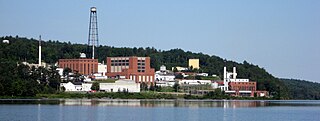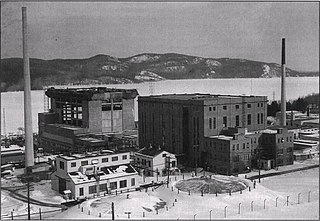
The CANDU is a Canadian pressurized heavy-water reactor design used to generate electric power. The acronym refers to its deuterium oxide moderator and its use of uranium fuel. CANDU reactors were first developed in the late 1950s and 1960s by a partnership between Atomic Energy of Canada Limited (AECL), the Hydro-Electric Power Commission of Ontario, Canadian General Electric, and other companies.
NRX was a heavy-water-moderated, light-water-cooled, nuclear research reactor at the Canadian Chalk River Laboratories, which came into operation in 1947 at a design power rating of 10 MW (thermal), increasing to 42 MW by 1954. At the time of its construction, it was Canada's most expensive science facility and the world's most powerful nuclear research reactor. NRX was remarkable both in terms of its heat output and the number of free neutrons it generated. When a nuclear reactor such as NRX is operating, its nuclear chain reaction generates many free neutrons. In the late 1940s, NRX was the most intense neutron source in the world.

Chalk River Laboratories is a Canadian nuclear research facility in Deep River, about 180 km (110 mi) north-west of Ottawa.
Atomic Energy of Canada Limited (AECL) is a Canadian federal Crown corporation and Canada's largest nuclear science and technology laboratory. AECL developed the CANDU reactor technology starting in the 1950s, and in October 2011 licensed this technology to Candu Energy.

Bruce Nuclear Generating Station is a nuclear power station located on the eastern shore of Lake Huron in Ontario, Canada. It occupies 932 ha of land. The facility derives its name from Bruce Township, the local municipality when the plant was constructed, now Kincardine due to amalgamation. With eight CANDU pressurized heavy-water reactors, it was the world's largest fully operational nuclear generating station by total reactor count and the number of currently operational reactors until 2016, when it was exceeded in nameplate capacity by South Korea's Kori Nuclear Power Plant. The station is the largest employer in Bruce County, with over 4000 workers.

The Clinton Power Station is a nuclear power plant located near Clinton, Illinois, USA. The power station began commercial operation on November 24, 1987 and has a nominal net electric output of 1062 MWe. Due to inflation and cost overruns, Clinton's final construction cost was $4.25 billion, nearly 1,000% over the original budget of $430 million and seven years behind schedule.
The Multipurpose Applied Physics Lattice Experiment (MAPLE), later renamed MDS Medical Isotope Reactors (MMIR), was a dedicated isotope-production facility built by AECL and MDS Nordion. It was intended to include two identical reactors, as well as the isotope-processing facilities necessary to produce a large portion of the world's medical isotopes, especially molybdenum-99, medical cobalt-60, xenon-133, iodine-131 and iodine-125. An operational license for the MAPLE 1 reactor was granted in 1999, and the reactor went critical for the first time soon after. However, problems with the reactor, most notably a positive power co-efficient of reactivity, led to the cancellation of the project in 2008.

The ZEEP reactor was a nuclear reactor built at the Chalk River Laboratories near Chalk River, Ontario, Canada. ZEEP first went critical at 15:45 on September 5, 1945. ZEEP was the first operational nuclear reactor outside the United States.

Research reactors are nuclear fission-based nuclear reactors that serve primarily as a neutron source. They are also called non-power reactors, in contrast to power reactors that are used for electricity production, heat generation, or maritime propulsion.
The National Research Universal (NRU) reactor was a 135 MW nuclear research reactor built in the Chalk River Laboratories, Ontario, one of Canada’s national science facilities. It was a multipurpose science facility that served three main roles. It generated radionuclides used to treat or diagnose over 20 million people in 80 countries every year. It was the neutron source for the NRC Canadian Neutron Beam Centre: a materials research centre that grew from the Nobel Prize-winning work of Bertram Brockhouse. It was the test bed for Atomic Energy of Canada Limited to develop fuels and materials for the CANDU reactor. At the time of its retirement on March 31, 2018, it was the world's oldest operating nuclear reactor.

The SLOWPOKE is a family of low-energy, tank-in-pool type nuclear research reactors designed by Atomic Energy of Canada Limited (AECL) beginning in the late 1960s. John W. Hilborn is the scientist most closely associated with their design. They are beryllium-reflected with a very low critical mass, but provide neutron fluxes higher than available from a small particle accelerator or other radioactive sources.
The Whiteshell Laboratories, originally known as the Whiteshell Nuclear Research Establishment (WNRE) was an Atomic Energy of Canada (AECL) laboratory in Manitoba, northeast of Winnipeg. It was originally built as a home for the experimental WR-1 reactor, but over time came to host a variety of experimental systems, including a SLOWPOKE reactor and the Underground Research Laboratory to study nuclear waste disposal. Employment peaked in the early 1970s at about 1,300, but during the 1980s the experiments began to wind down, and in 2003 the decision was made to close the site. As of 2017 the site is undergoing decommissioning with a planned completion date in 2024. The decommissioning process for WR-1 involves transporting low-level nuclear waste to another Canadian Nuclear Laboratories (CNL) research site, Chalk River Laboratories in Ottawa for containment, and encasing the reactor in concrete. The details of this process continue to be criticized, evaluated, and revised.
ZED-2 is a zero-power nuclear research reactor built at the Chalk River Laboratories in Ontario, Canada. It is the successor to the ZEEP reactor. Designed by AECL for CANDU reactor support, the unit saw first criticality on 7 September 1960. The reactor is still operating at Chalk River where it is used for reactor physics and nuclear fuel research.

A swimming pool reactor, also called an open pool reactor, is a type of nuclear reactor that has a core immersed in an open pool usually of water.

Cobalt-60 (60Co) is a synthetic radioactive isotope of cobalt with a half-life of 5.2714 years. It is produced artificially in nuclear reactors. Deliberate industrial production depends on neutron activation of bulk samples of the monoisotopic and mononuclidic cobalt isotope 59
Co
. Measurable quantities are also produced as a by-product of typical nuclear power plant operation and may be detected externally when leaks occur. In the latter case the incidentally produced 60
Co
is largely the result of multiple stages of neutron activation of iron isotopes in the reactor's steel structures via the creation of its 59
Co
precursor. The simplest case of the latter would result from the activation of 58
Fe
. 60
Co
undergoes beta decay to the stable isotope nickel-60. The activated cobalt nucleus emits two gamma rays with energies of 1.17 and 1.33 MeV, hence the overall equation of the nuclear reaction is: 59
27Co
+ n → 60
27Co
→ 60
28Ni
+ e− + 2 γ
Nuclear Power Demonstration was the first Canadian nuclear power reactor, and the prototype for the CANDU reactor design. Built by Canadian General Electric, in partnership with Atomic Energy of Canada Limited (AECL) and the Hydro Electric Power Commission of Ontario it consisted of a single 22 MWe pressurized heavy water reactor (PHWR) unit located in Rolphton, Ontario, not far from AECL's Chalk River Laboratories. NPD was owned by AECL and operated by Ontario Hydro.

The Douglas Point Nuclear Generating Station was Canada’s first full-scale nuclear power plant and the second CANDU pressurised heavy water reactor. Its success was a major milestone and marked Canada's entry into the global nuclear power scene. The same site was later used for the Bruce Nuclear Generating Station.
Nuclear power in Canada is provided by 19 commercial reactors with a net capacity of 13.5 gigawatt (GW), producing a total of 95.6 terawatt-hours (TWh) of electricity, which accounted for 16.6% of the country's total electric energy generation in 2015. All but one of these reactors are located in Ontario, where they produced 61% of the province's electricity in 2019. Seven smaller reactors are used for research and to produce radiopharmaceuticals for use in nuclear medicine.
The Whiteshell Reactor No. 1, or WR-1, was a Canadian research reactor located at AECL's Whiteshell Laboratories (WNRL) in Manitoba. Originally known as Organic-Cooled Deuterium-Reactor Experiment (OCDRE), it was built to test the concept of a CANDU-type reactor that replaced the heavy water coolant with an oil substance. This had a number of potential advantages in terms of cost and efficiency.

The Embalse Nuclear Power Station is one of three operational nuclear power plants in Argentina. It is located on the southern shore of a reservoir on the Río Tercero, near the city of Embalse, Córdoba, 110 km south-southwest of Córdoba City.










